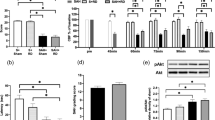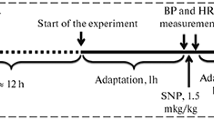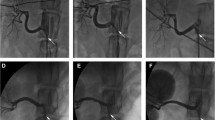Abstract
Bilateral common carotid artery ligation (BCCAL) leads to acute craniocervicocerebral ischemia, retrograde blood flow, increased blood pressure, and significant hemodynamic and histomorphological changes at the posterior cerebral vasculature. We examined the potential relationship between denervation injury following BCCAL-induced cervical sympathetic trunk (CST) ischemia and heart rate after permanent BCCAL. Rabbits (n = 25) were randomly divided into three groups: an unoperated control group (GI, n = 6); a sham-operated control group (GII, n = 6), and an experimental group subjected to BCCAL (GIII, n = 13); and then followed for one month. All animals were then sacrificed and the stellate ganglia (STGs) were examined histologically using stereological methods. The densities of degenerated neurons in the STGs were compared with heart rates and the results were analyzed with the Mann–Whitney U test. The mean normal neuron density in STGs was 10.340 ± 954/mm3 and the degenerated neuron density was 12 ± 3/mm3 in the GI group (p > 0.5). The mean heart rates and degenerated neuron densities of STGs were recorded as 267 ± 19/min and 237 ± 45/mm3 in GII (p < 0.005 for GII vs. GI); and 190 ± 11/min 1421 ± 230/mm3 in GIII (p < 0.0001 for GIII vs. GI and p < 0.005 for GIII vs. GII). An inverse and meaningful association was observed between the heart rate and degenerated neuronal density in the STGs. BCCAL may lead to hazardous histomorphological changes in the CST. A high density of degenerated neurons in the STG may provoke excessive sympathetic hypoactivity-related cardiac damage and bradyarrhythmias after stenoocclusive carotid artery diseases.




Similar content being viewed by others
References
Oldendorf, W. H. (1989). Trophic changes in the arteries at the base of the rat brain in response to bilateral common carotid ligation. Journal of Neuropathology & Experimental Neurology, 48, 534–547.
Onen, M. R., Yilmaz, I., Ramazanoglu, L., Tanrıverdi, O., Aydin, M. D., Kanat, A., et al. (2016). Rational roots of sympathetic overactivity by neurogenic pulmonary edema modeling arising from sympathyco-vagal imbalance in subarachnoid hemorrhage: An experimental study. World Neurosurgery, 92, 463–470.
Yilmaz, I., Eseoglu, M., Onen, M. R., Tanrıverdi, O., Kilic, M., Yilmaz, A., et al. (2017). Inverse association between basilar artery volume and neuron density in the stellate ganglion following bilateral common carotid artery ligation: An experimental study. World Neurosurgery, 100, 138–143.
Huang, B., Yu, L., Scherlag, B. J., Wang, S., He, B., Yang, K., et al. (2014). Left renal nerves stimulation facilitates ischemia-induced ventricular arrhythmia by increasing nerve activity of left stellate ganglion. Journal of Cardiovascular Electrophysiology, 25, 1249–1256.
Lujan, H. L., Palani, G., Zhang, L., & DiCarlo, S. E. (2010). Targeted ablation of cardiac sympathetic neurons reduces the susceptibility to ischemia-inducedsustained ventricular tachycardia in conscious rats. American Journal of Physiology-Heart and Circulatory Physiology, 298, H1330–H1339.
Sterio, D. C. (1984). The unbiased estimation of number and sizes of arbitrary particles using the disector. Journal of Microscopy, 134, 127–136.
Aydin, M. D., Ozkan, U., Gündoğdu, C., & Onder, A. (2002). Protective effect of posterior cerebral circulation on carotid body ischemia. Acta Neurochirurgica, 144, 369–372.
Eseoglu, M., Yilmaz, I., Karalar, M., Aydin, M. D., Kayaci, S., Gundogdu, C., et al. (2014). The role of sympathectomy on the regulation of basilar artery volume changes in stenoocclusive carotid artery modeling after bilateral common carotid artery ligation: An animal model. Acta Neurochirurgica (Wien), 156, 963–969.
Aygul, R., Aydin, M. D., Kotan, D., Demir, R., Ulvi, H., Karalar, M., et al. (2013). Role of the trigeminal system on posterior communicating artery remodelization after bilateral common carotid artery ligation. Analytical and Quantitative Cytopathology and Histopathology 35, 217–225.
Jago, R., Heath, D., & Smith, P. (1982). Structure of the glomic arteries. The Journal of Pathology, 138, 205–218.
Milei, J., Lavezzi, A. M., Bruni, B., Grana, D. R., Azzato, F., & Matturri, L. (2009). Carotid barochemoreceptor pathological findings regarding carotid plaque status and aging. Canadian Journal of Cardiology, 25, e6–e12.
Chao, A. C., Chern, C. M., Kuo, T. B., Chou, C. H., Chuang, Y. M., Wong, W. J., et al. (2003). Noninvasive assessment of spontaneous baroreflex sensitivity and heart rate variability in patients with carotid stenosis. Cerebrovascular Diseases, 16, 151–157.
Nasr, N., Pavy-Le Traon, A., & Larrue, V. (2005). Baroreflex sensitivity is impaired in bilateral carotid atherosclerosis. Stroke, 36, 1891–1895.
Tubbs, R. S., Salter, G., Wellons, J. C. 3rd, & Oakes, W. J. (2002). Blood supply of the human cervical sympathetic chain and ganglia. European Journal of Morphology, 40, 283–288.
Moskowitz, M. A., Renhard, J. F., Romero, J., Melamed, E., & Pettibone, D. J. (1979). Neurotransmitters and the fifth cranial nerve: Is there a relation to the headache phase of migraine? Lancet, 2, 883–885.
Aydin, M. D., Bayram, E., Atalay, C., Aydin, N., Erdogan, A. R., Gundogdu, C., et al. (2006). The role of neuron numbers of the petrozal ganglion in the determination of blood pressure. An experimental study. Minimally Invasive Neurosurgery, 49, 328–330.
Bharati, S., & Lev, M. (1992). The pathologic changes in the conduction system beyond the age of ninety. American Heart Journal, 124, 486–496.
Song, Y., Laaksonen, H., Saukko, P., Toivonen, S., & Zhu, J. (2001). Histopathological findings of cardiac conduction system of 150 finns. Forensic Science International, 119, 310–317.
Chow, L. T., Chow, S. S., Anderson, R. H., & Gosling, J. A. (2001). Autonomic innervation of the human cardiac conduction system: changes from infancy to senility-an immunohistochemical and histochemical analysis. The Anatomical Record, 264, 169–182.
Polydorou, A., Megalooikonomos, P., Portinos, A., Prapa, E., Kara, P., Tsiga, A., et al. (2010). Persistent bradycardia in a patient with coronary artery disease and concomitant carotid artery disease. Hospital Chronicles, 5(1 Sup), 101–104.
Kirby, D. A., & Vatner, F. (1987). Enhanced responsiveness to carotid baroreceptor unloading in conscious dogs during development of perinephritic hypertension. Circulation Research, 61, 678–686.
Vatner, S. F., & Manders W. T. (1979). Depressed responsiveness of the carotid sinüs reflex in conscious newborn animals. American Journal of Physiology-Heart and Circulatory Physiology, 237, H40–H43.
Kumagai, K., & Reid, I. A. (1994). Losartan inhibits sympathetic and cardiovascular responses to carotid occlusion. Hypertension, 23, 827–831.
Schröder, H. J., Rybakowski, C., Eisermann, K., Tchirikov, M., & Ostermann, S. (2000). Unloading of baroreceptors by carotid occlusion does not increase heart rate in fetal sheep. European Journal of Obstetrics & Gynecology and Reproductive Biology, 92, 265–272.
Fujiki, A., Masuda, A., & Inoue, H. (1999). Effects of unilateral stellate ganglion block on the spectral characteristics of heart rate variability. Japanese Circulation Journal, 63, 854–858.
Rogers, M. C., Abildskov, J. A., & Preston, J. B. (1973). Cardiac effects of stimulation and block of the stellate ganglion. Anesthesiology, 39, 525–533.
Schwartz, P. J. (1984). The rationale and the role of left stellectomy for the prevention of malignant arrhythmias. Annals of the New York Academy of Sciences, 427, 199–221.
Song, J. G., Hwang, G. S., Lee, E. H., Leem, J. G., Lee, C., Park, P. H., et al. (2009). Effects of bilateral stellate ganglion block on autonomic cardiovascular regulation. Circulation Journal, 73, 1909–1913.
Vaseghi, M., Zhou, W., Shi, J., Ajijola, O. A., Hadaya, J., Shivkumar, K., et al. (2012). Sympathetic innervation of the anterior left ventricularwall by the right and left stellate ganglia. Heart Rhythm, 9, 1303–1309.
Kawashima, T. (2011). Anatomy of the cardiac nervous system with clinical and comparative morphological implications. Anatomical Science International, 86, 30–49.
Author information
Authors and Affiliations
Corresponding author
Ethics declarations
Conflict of interest
All authors declare that they have no conflict of interest.
Additional information
Handling Editor: Y. James Kang.
Rights and permissions
About this article
Cite this article
Koza, Y., Bayram, E., Aydin, M.D. et al. Predictive Role of the Cervical Sympathetic Trunk Ischemia on Lower Heart Rates in an Experimentally Induced Stenoocclusive Carotid Artery Model by Bilateral Common Carotid Artery Ligation. Cardiovasc Toxicol 19, 56–61 (2019). https://doi.org/10.1007/s12012-018-9473-z
Published:
Issue Date:
DOI: https://doi.org/10.1007/s12012-018-9473-z




